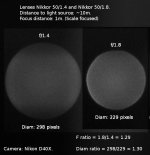rxmd
May contain traces of nut
Here is an interesting piece which, among other things, points out the advantage and necessity with wide angle lenses of the CCD sensor in digital M Leicas as compared to the CMOS sensor in many DSLR's.
Firstly, I think a fair share of the light loss exhibited in the graphs can be attributed to manufacturers mislabeling their lenses - it's been known for ages that when you buy an f/1.2 lens, you may actually get a T/1.3 or even an f/1.3 lens. Lens tests have regularly shown this since the 1950s, and it's a bit laughable when people rediscover that a f/1.2 lens is a third of a stop slower, talk about "T-stop loss at the sensor" and never measure what T-stop the lens actually has. (DxO doesn't do that, all they do is look at RAW files.)
The article also fails to explain why T-stop losses at the sensor should be dependent on the aperture set in the lens at all. Why should there be more light loss at the sensor at f/1.4 than at f/5.6? And if light loss at the sensor is the same across apertures, his whole argument about fast wide lenses being unnecessary breaks down, because slow tele lenses have the same problem.
Also note that his argument about T-stops and depth of field is completely meaningless. Depth of field is determined by the ratio of focal length to the diameter of the projected aperture. You can have an f/1.2 lens with a T-stop of 8 and depth of field will still be that of a f/1.2 lens. The argument that depth of field is different because "marginal light rays don't hit the sensor" is comical at best, because that solely depends on sensor size, which he doesn't talk about at all.
Finally, the article says absolutely nothing about CCD vs. CMOS sensors. A fair share of the cameras in the comparison actually have CCD sensors in them. All Nikons before the D300 used CCD sensors, and the D300's CMOS sensor exhibits the same "light loss" as the D200's CCD sensor. In short, what the article describes is completely independent of sensor technology.
Last edited:



